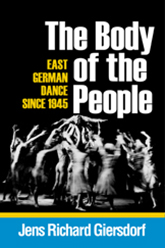|
The Body of the People
East German Dance since 1945
Jens Richard Giersdorf
Studies in Dance History
Published under the auspices of the Society of Dance History Scholars
A Choice Outstanding Academic Book
“A stunning work that opens the door to East German dance, a surprisingly little-known area of study.”
—Gay Morris, author of A Game for Dancers: Performing Modernism in the Post-War Years
The Body of the People is the first comprehensive study of dance and choreography in East Germany as a disciplinary and resistive tool. More than twenty years after the fall of the Berlin Wall, Jens Richard Giersdorf investigates a national dance history in the German Democratic Republic, from its founding as a Communist state that supplanted the Soviet zone of occupation in 1949 through the aftermath of its collapse forty years later, examining complex themes of nationhood, ideology, resistance, and diaspora through an innovative mix of archival research, critical theory, personal narrative, and performance analysis.
Giersdorf looks closely at uniquely East German dance forms—including mass exercise events, national folk dances, Marxist-Leninist visions staged by the dance ensemble of the armed forces, the vast amateur dance culture, East Germany's version of Tanztheater, and socialist alternatives to rock 'n roll—to demonstrate how dance was used both as a form of corporeal utopia and of embodied socialist propaganda and indoctrination. The Body of the People also explores the artists working in the shadow of official culture who used dance and movement to critique and resist state power, notably Charlotte von Mahlsdorf, Arila Siegert, and Fine Kwiatkowski. Giersdorf considers a myriad of embodied responses to the Communist state even after reunification, analyzing the embodiment of the fall of the Berlin Wall in the works of Jo Fabian and Sasha Waltz, and the diasporic traces of East German culture abroad, exemplified by the Chilean choreographer Patricio Bunster.
Jens Richard Giersdorf is assistant professor of dance at the University of California, Riverside. Prior to his academic career he was a dancer and dramaturg with Tanzbühne Leipzig, in the former German Democratic Republic.
Praise
“Giersdorf provides a spectacular, theoretical recounting of East German dance after WWII.”
—Choice
“At last, more than twenty years after the fall of the Berlin Wall, Jens Richard Giersdorf gives us a compelling account of dance in the German Democratic Republic, the Communist state that supplanted the Soviet zone of occupation in 1949 and collapsed forty years later.”
—Susan Manning, Northwestern University
|

PAPERBACK ORIGINAL
May 2013
LC: 2012013013 GV
248 pp. 6 x 9
20 b/w photos
|

